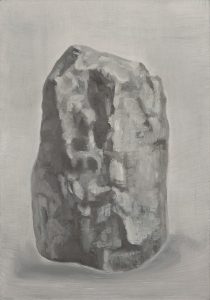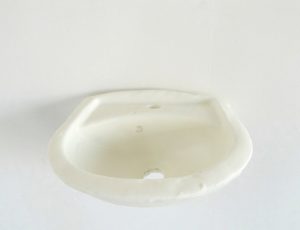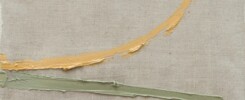space52 | Booth 5
Exhibition opening:
Thursday, 17 May 2018 at 19:00
Exhibition Dates:
Thursday, 17 May 2018 to Sunday, 20 May 2018
http://platformsproject.com/platforms/space52/
Participants Artists: Dionisis Christofilogiannis, Georgia Kotretsos, Andrei Nuţu, Andreas Mallouris, Eva Mitala, Pantelis Vitaliotis-Magneto, Iraklis Fovakis, Vasilis Zografos
Vasilis Zografos

Three paintings depicting different versions of rock formations, setup as portraits, exuding a sense of timelessness. Remaining extracts of amorphous matter, even when their crystalline structure is seen through. Thick and solid amorphous matter that allows for some visible holes like scattered nests. The poetic of the dense and the amorphous, as displayed at these three paintings by Vasilis Zografos, naturally leads to what one might call “the original sight of a primordial phenomenology”. In other words, a view of something that despite its enormity and undefined old age, may lie right here—in front of us—an object to be looked upon and considered. So, three singular accumulat

ions of the infinite: a solitary, amorphous entity; another one positioned on a plinth of its own matter; and a crystal, two-part, bipolar, arrogant body, which renders to the in-between, free-of-forms space the power to pass-through into what is essentially a vastness with no borders. These reserves, these formations subjected to our gaze, state their stolidity in an imposing way; like hiding places keeping their secrets well inside, they have transfixed the creative imagination and offer an absolute, almost “transcendental” silence that is conducive for reflection and contemplation. Thalia Stefanidou, Art Critic / Historian – Curator
Pantelis Vitaliotis – Magneto


Pantelis Vitaliotis – Magneto’s latest works are paintings, acrylic on canvas, opens up a microcosm on psychology practices through his relation on graphic design and visual arts. Each form, depending on the position and the correlation with the other forms signify feelings and emotions. Certain motifs, as the squares and the spheres have a persistent presence in his works and create a coherence between the present and his earlier creations, in semantic terms. Black undefined shapes in conjunction with the horizontal, vertical and circular lines either form an enclosed space inside the circuit or float in the penetrable space of the flat white background, depending on the stance from which one attempts to “read” the image. As the geometric structure and simplicity of form is disrupted by and at the same time is combined harmonically with organic abstract shapes, it becomes a dynamic composition. The balance between order and disorder signals a transition from the security of the familiar to the exploration of a free form of expression. He gradually moves from the solid shapes that preoccupied his earlier works to more free forms, demonstrating in this way, both the liberation of the gesture as well as his artistic expression. The plasticity of the forms is reminiscent of Juan Miró’s mature style whilst the repetition of certain shapes in his pictures recall the Surrealists’ motif and minimalism. Elizabeth Louizou, Art Historian
Andrei Nuţu

While keeping some elements that belong to the traditional portrait, such as the accuracy of proportion and lighting, the works aim to tackle portraiture from a contemporary perspective as well, particularly by exploiting the various ways of both seeing and depicting a face – and, consequently, the person behind it. Traditional portraits usually only hint at what rests behind someone’s appearance – and, needless to say , their power of suggestion is sometimes disarmingly charming. However, the present works invite the viewer to look beyond what is naturally visible to the naked eye, more precisely by depicting not only the surface of the Self, but also its inside, as seen through the eyes of the painter. The combination of black and white, with its indisputable feeling of honesty, is meant to help the viewers focus not on the potential nuances of colours, but rather on the essential that, according Antoine de Saint-Exupéry, is invisible to the eye. Because even though our looks might recommend us as people who “have it together”, what lies behind them is often far from that. This is a look at anyone – at the time and place when they’re vulnerable and do not feel whole, but rather fragmented or duplicated, a look at strangers but, at the same time, at ourselves, when we feel like we failed to grab the end of the comet tail that was meant to take us on the journey to the time of our lives.
Andreas Mallouris

Dictations. As in the relationship between the reciter(s) and the recorder(s). As in the transcription of spoken word, the teaching of language, the instiller of morals. Dictations as constructing and establishing the “Superego”. As a ceremony that impacts social hierarchy and branding. This work on dictations, attempts to perform an anatomical dissection to uncover the layers existing between the ‘Superego’ and the ‘It’ in order to expose the ‘Ego’. Within the context of Freud’s Psychoanalytic theory, the ‘Superego’ constitutes the morals and values in an individual and interacts with the ‘It’, the world of instincts and impulses. It is an exploration in the fields of acquired obsessions, as the result of a dictated suppressive ‘Superego’ in a society where the influence of religion, nationalism and masculinity are dominant. Sexuality exposed as an intimate meeting point of the ‘Superego’ and ‘It’.

Distinct elements of BDSM in the context of the dipole of pain and pleasure, invite the viewer into the profound visual and sensational subculture. White, not innocent as we define it, has the property to cover any stain and purify elegantly the surfaces. Soap, as white in colour and the scent of fresh air, as a domestic material itself involved in a ceremony of scrubbing away any trace of violence, an obsession. There is no intention to reconstruct but to dissect and present a scene in an open dialogue.
Eva Mitala

Abstract unique silkscreen prints, working across both large and small canvases. Compositional structure and intuitive touch lead to layered circumstances that result in every new piece. The artist creates a language of things in process interested in poetic irregularity and variability which are difficult to mass produce even with the medium of silkscreen. Stepping on the irreguralities of experimental silkscreen techniques with its defaults and errors, Eva Mitala interested in the imagistic element of the unfinished, suggests an irregular cropping, editing and combining actions in her practice. The images made involving an element of risk and uncertainty, focus on the look and feel of things, clearly defining that no form or element in any piece shall stand out above any other.
Georgia Kotretsos

Georgia Kotretsos is a visual artist and a professional spectator based in Athens, Greece. With her work, she critiques the conformity of seeing by studying, proposing and practicing liberating and anarchic approaches of looking at art in an effort to support that seeing is site-specific and spectatorial emancipation the source of our art knowledge. Through her research-based practice, she encourages speculative approaches on how knowledge is and/or could be produced.“Objectified” is the prelude of an endless series of works to be produced in order to highlight the unidentified presence artworks cast on the world.
Iraklis Fovakis

The work functions as an amulet. A symbolic representation of instinctive forces, specifically those inner processes of our most inaccessible psychological phenomena, the Snake – traditionally known as a chthonic creature of the underworld – bears in consciousness a transcendental meaning, relative to the threatening nature of the eternal conflict between the “conscious” and the “instinct”. Does the Snake denote the demon on earth, the soul of the dead and the dark lord of the Ophites? Or perhaps, as the Gnostic symbols declare, it is the most spiritual and wise of all the creatures? Even today, when we want to emphasize on the charismatic aspects of a hero’s persona, his creative spirit and his will for life (libido), we recognize him as a “Sparkling Snake”. This is why the alchemical opus Musaeum Hermeticum attributes to the “ouroboros” (the serpent or dragon eating its own tail) a vivid and even therapeutic quality. Snake was in ancient time the therapeutic symbol of Aesculapius and it remains today the dominant emblem of medical science. The artifact “Snake Bearer” of Iraklis Fovakis, an attempt of the artist himself to charm the Snake inside him, makes a significant point. It points out that the way to the source of life is through the dark and the so-called occult, through the primitive and the instinctive. Foteini Kopiloglou Curator – Museologist
Dionisis Christofilogiannis

Christofilogiannis’s new works are sculptural installations made from cork, metal, porcelain, oil on canvas and rice paper. Τhe materials are covered in holes which act as spaces of freedom. They suggest a way of looking at the world through limitations, as if one is in prison looking out at the world beyond its walls, but also through the uterus of the self and all that surrounds it. “The hole symbolizes the paradox of ‘the sense of freedom’ when one is limited”, continues Christofilogiannis. “It depends on where one stands…inside or outside the hole. It is often the case that one looks through a hole, but one can also shoot through it. One can hide within it in order to scream and one can also die in there. Every so often in history, we come across holes in ancient statues and architectural locations which are interpreted as symbols of perfection, immortality, kindness and magic. Holes have formed part of various rituals. We also find them in ancient theatre, and more specifically on masks; there, openings were made large enough for the actors’ voices to be amplified. Volumes and shapes that reference organic forms, internal synapses and attachments of life, the centre of the psyche that can be either open or shut, the feeling of being trapped and the sense, or the illusion of freedom, the matrix of things, our ontological origins. Dionisis Christofilogiannis’s works seem to have been produced on the basis of a freedom born out of limitation, an impossible freedom which also constitutes our dark roots. … text by Thanos Stathopoulos
Freedom in Form, Silence in Matter: Contemporary Ontologies by Dionisis Christofilogiannis
Introduction
The 2018 Platforms Project in Athens hosted Booth 5 by Space52, presenting an exhibition that brought together a constellation of artists exploring psychological, phenomenological, and symbolic dimensions of contemporary art. The works by Dionisis Christofilogiannis, Georgia Kotretsos, Andrei Nuţu, Andreas Mallouris, Eva Mitala, Pantelis Vitaliotis–Magneto, Iraklis Fovakis, and Vasilis Zografos engage deeply with themes of visibility, materiality, identity, and perception. This essay examines how these artists propose aesthetic and ontological inquiries through abstraction, symbolism, and psychoanalytic critique, invoking traditions from phenomenology to minimalism and from surrealism to post-structuralism.
Phenomenological Encounters with Form
Vasilis Zografos’ paintings present geological formations as visual poems of permanence and mystery. Through thick oil applications and almost sculptural surfaces, his untitled 2017 works frame rocks as portrait subjects—silent but loaded with presence. As Thalia Stefanidou notes, they evoke “a view of something that… may lie right here—in front of us—an object to be looked upon and considered” (Stefanidou, 2018). This reflects the phenomenological tradition, particularly in Maurice Merleau-Ponty’s conception of the “flesh of the world,” where objects do not just exist but invite reciprocal perception (Merleau-Ponty, 1968).
Geometric Emotion and Formal Tension
Pantelis Vitaliotis–Magneto’s paintings utilize geometry and color to navigate between structure and spontaneity. Repetitive motifs such as squares and spheres serve both as formal anchors and emotional signifiers. According to Elizabeth Louizou (2018), this interplay articulates “a transition from the security of the familiar to the exploration of a free form of expression.” His work draws comparisons to the mature style of Joan Miró and Minimalist principles, where form transcends function and invites symbolic readings (LeWitt, 1967).
Portraiture as Psychological Landscape
Andrei Nuţu rethinks the portrait not as a representation of identity but as a site of vulnerability and fragmentation. Through monochromatic tones and expressive distortions, his figures resist completion. Nuţu’s approach recalls Gilles Deleuze’s idea of the “dividual” subject—fragmented, shifting, and fluid (Deleuze & Guattari, 1987). The faces become masks of interiority, echoing Antoine de Saint-Exupéry’s idea that “what is essential is invisible to the eye” (Saint-Exupéry, 1943).
Dictated Forms and Superego Structures
Andreas Mallouris’s sculptures, such as White baton and White basin, materialize the invisible forces of social order—morality, repression, and control. Explicit references to Freud’s psychoanalytic triad—the Id, Ego, and Superego—underscore the works’ conceptual backbone (Freud, 1923). The tension between materials (soap, silicon, white color) and references (BDSM, ritual purity) exposes the contradictions within imposed moral structures. His work embodies Michel Foucault’s notion of “disciplinary power,” where control is enacted through bodily and psychological conditioning (Foucault, 1977).
Material Uncertainty and Experimental Printmaking
Eva Mitala’s silkscreens embrace the accidental, the misaligned, and the unfinished. By welcoming the “errors” of her medium, Mitala reclaims the hand in printmaking, subverting its traditional association with mechanical reproduction (Benjamin, 1936). As she “suggests an irregular cropping… combining actions in her practice,” her work becomes a visual metaphor for risk, time, and impermanence.
The Politics of the Gaze
Georgia Kotretsos challenges normative spectatorship with her “Objectified” series. Her methodology draws on feminist and post-structuralist discourses that interrogate the gaze. Influenced by theorists such as Laura Mulvey (1975) and Jacques Rancière (2009), Kotretsos posits that “seeing is site-specific,” and that “spectatorial emancipation [is] the source of our art knowledge.” Her work not only visualizes but theorizes viewing itself, collapsing the boundary between subject and spectator.
Chthonic Symbols and Inner Archetypes
Iraklis Fovakis’s Slough of a 4.5 boidae snake uses snake imagery to explore archetypal and unconscious forces. Drawing on both Gnostic symbolism and alchemical traditions (Jung, 1953), the serpent becomes a bearer of both threat and healing. The velvet, pearls, and plexiglass materials elevate the snake to a sacred object—a personal and collective totem. As Kopiloglou (2018) asserts, the sculpture “makes a significant point… that the way to the source of life is through the dark and the so-called occult.”
Sculpting Freedom from Limitation
Dionisis Christofilogiannis’s installations of pierced materials serve as metaphors for constrained vision and paradoxical freedom. The motif of the “hole” becomes multivalent—a prison, a passage, a wound, and a threshold. Thanos Stathopoulos (2018) situates this within a phenomenology of limitation, where “freedom born out of limitation” becomes both political and existential. These works reflect existentialist claims about meaning being forged precisely in the constraints of one’s condition (Sartre, 1943).
Conclusion
Space52’s presentation at Booth 5 transcends conventional curatorial formats to offer a richly philosophical, visually provocative, and psychologically charged experience. Through diverse media—painting, sculpture, printmaking, and mixed media—the participating artists address questions of perception, freedom, identity, and materiality. The exhibition not only reflects the plurality of contemporary art practices but affirms the enduring power of visual culture to interrogate, unsettle, and illuminate the depths of the human condition.
References
-
Benjamin, W. (1936). The Work of Art in the Age of Mechanical Reproduction.
-
Deleuze, G., & Guattari, F. (1987). A Thousand Plateaus: Capitalism and Schizophrenia. University of Minnesota Press.
-
Foucault, M. (1977). Discipline and Punish: The Birth of the Prison. Pantheon.
-
Freud, S. (1923). The Ego and the Id.
-
Jung, C. G. (1953). Psychology and Alchemy. Princeton University Press.
-
LeWitt, S. (1967). “Paragraphs on Conceptual Art.” Artforum.
-
Louizou, E. (2018). Text on Pantelis Vitaliotis – Magneto, Platforms Project Catalogue.
-
Mulvey, L. (1975). “Visual Pleasure and Narrative Cinema.” Screen, 16(3), 6–18.
-
Rancière, J. (2009). The Emancipated Spectator. Verso.
-
Saint-Exupéry, A. de (1943). The Little Prince.
-
Sartre, J.-P. (1943). Being and Nothingness.
-
Stefanidou, T. (2018). Text on Vasilis Zografos, Platforms Project Catalogue.
-
Stathopoulos, T. (2018). Text on Dionisis Christofilogiannis, Platforms Project Catalogue.
-
Kopiloglou, F. (2018). Text on Iraklis Fovakis, Platforms Project Catalogue.


